Causes of Erectile Dysfunction
Many factors are responsible for erectile dysfunction. With advancing age male sex hormone testosterone decreases, it is the main cause of Erectile Dysfunction. Apart from this many medical condition such as coronary artery disease, hypertension, diabetes mellitus, injury to penis, hormonal imbalance are the causes of erectile dysfunction. Broadly Erectile dysfunction can be divided into two categories, Physiological and Psychological. Let’s know in details the causes of erectile dysfunction.
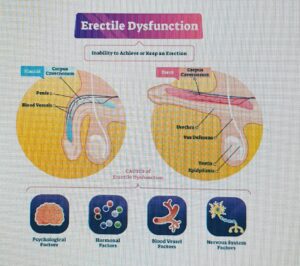
Physiological Causes of Erectile Dysfunction
Cardiovascular:- Patient suffering from chronic heart disease, coronary artery disease, hypertension or atherosclerosis.
Neurological:- Parkinson’s disease, congenital neurological defects, nervous system weakness, multiple sclerosis.
Endocrinological:- Diabetes mellitus, hyperthyroidism.
Hormonal:- Reduced testosterone, Raised prolactin, Raised estrogen.
Renal:- Chronic kidney disease.
Medical Conditions Causing ED
Hypertension:- Interference in blood flow due to HTN.
Hyperlipidemia:- Raised cholesterol causes blockage in blood vessels reducing blood flow.
DM-type2:- Diabetes damages the blood vessels and reduce the blood flow.
Surgery:- Surgery of pelvis region can damage the blood flow of that region, surgery for bladder cancer, surgery for prostate cancer.
Peyronie disease:- Penis bend due to scaring in penile tissues. Causes pain during sexual act. It can be treated only by surgery.
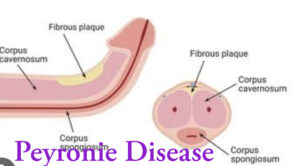

Medication Cause of Erectile Dysfunction
Antihypertensive:- Certain B-blocker such as metoprolol etc.
Antidiabetic:- Metformin etc.
Antidepressants:- Such as Escitalopram,cyclic antidepressant etc.
Antipsychotic:- Such as Risperidone, Olanzapine.
SSRIs:- Selective serotonin reuptake inhibitor such as Paroxetine etc.
Antiallergic:- Excess use of cetirizine, Levocetirizine etc.
Radiations:- For the treatment of cancer.
Psychological Causes of Erectile Dysfunction
Depression, Anxiety.
Stress
Fear of sexual failure.
Guilt about sexual performance.
Relationship Conflicts.
Poor body image.
Financial stress.


Life Style Related Cause of Erectile Dysfunction
Smoking:- Smoking causes narrowing of arteries and reduces blood flow.
Drinking:- Excessive use of Alcohol is one of the cause of ED.
Drug Addiction:- Use of drugs such as opium products, marijuana etc causes ED.
Physical inactivity:- No workout,no exercise causes reduced blood flow.
Obesity:- If BMI is more than 25 they are prone to have ED.
Who Are At Great Risk of ED
Erectile Dysfunction can affects any male, in any region or at any age after puberty. But mention below are at higher risk of having ED.
- If you are at the age of 40.
- If you are diabetic.
- If you are hypertensive.
- If you are in depression.
- If you are taking antidepressants,SSRIs,antihypertensive medicines.
- If your libido is reduced.
- If your BMI is 25 or more.
- If you are physically inactive.
- If you are taking medicine of hair loss i.e. finasteride.
- If you are using gym supplements.
- If you are consuming excessive alcohol.
- If you are chain smoker.
- If you have drug addiction.
Diagnosis of Erectile Dysfunction
The most important part in the treatment of ED is diagnosis. Proper diagnosis can cure the problem permanently. So Sexperts in our clinic Dr. SP Singh Clinics Pvt.Ltd. do their best in diagnosis of ED. They treat the root cause of the problem,so that patients get well permanently.

Patient’s Medical History
Patient’s medical history is taken in detail. He is asked for his age, blood group, marital status, job profile, any physical activity recently and in past, have consumed gym supplements or not, any history of smoking, drinking. Any health condition such as hypertension, heart disease, diabetes, thyroid ailments, epilepsy, tuberculosis, any neurological condition, any treatment for long term, medication for their ailments, have undergone any surgery recently or in past, living in which geographical area, any psychological problem such as OCD, Multiple personality disorder, depression, anxiety or stress, any financial stress etc.
Patient’s Sexual History
In addition to medical history sexual history is also taken in details. Patient is asked for any sexual experience, if married, any premarital sexual history, about extramarital affairs, any history of STDs i.e. sexual transmitted disease. About ongoing sexual problems, when he came to know about the condition first, had he taken any treatment about the problem, which medicines he had taken till now to overcome the problems, about relationship with partner. About morning erection, nocturnal erection, masturbation, nightfall, about body images in mind etc.

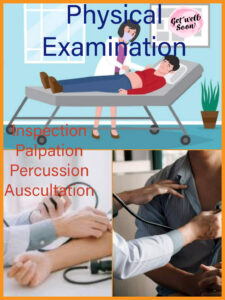
Physical Examination
Sexologist carefully examine the body of patient to see the sign of ED or other disease responsible for ED. Inspection of body, testicles and penis is done. Lower eyelid inspected for pallor-sign of anemia, upper eyelid for ictrus-sign of jaundice, nails and tongue for cyanosis-sign of hypoxemia, neck for thyroid disorder, testicles for sign of hypogonadism, penis size and shape, for any sign of deformity or Peyronie disease. Testicles are palpated for any sign of testicular torsion or any epididymal cyst, penis for phimosis. Auscultation for any sign of heart abnormality. Proper examination helps in diagnosis of ED and root cause of ED.
Laboratory Tests
For the proper diagnosis of ED, certain tests are required to rule out heart problems, vascular,hormonal,or neural cause:-
Complete Blood Count (CBC)
Lipid Profile
Liver Function Tests(LFT)
Renal Function Tests(RFT)
T3,T4,TSH
Testosterone Level
Prolactin
LH, FSH
Vit B12,
Vit D3
Urine R/E
Semen Analysis
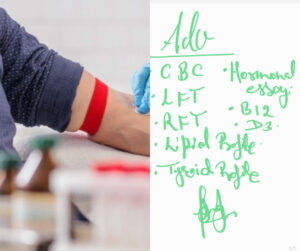

Psychological Assessment(IIEF)
International Index of Erectile Function is done for assessment of psychological factors. It is in the form of a questionnaire. It contains 15 questions having question from 5 categories. Each question have six (6) option varying from extreme low to extreme high and carry five (5) marks. Five categories are (i) Erectile Functions-6 question, (ii) Orgasmic Function-2 questions, (iii) Sexual Desire-2 questions (iv) Intercourse Satisfaction-3 question, (v) Overall Satisfaction-2 question. Depending upon the score obtained in each domain the cause of ED is determined.
Penile Doppler
For the assessment of arterial insufficiency, and venous leak penile ultrasonography is performed. To perform penile doppler intracavernosal injections are given to erect the penis. Penile doppler gives clear picture about:
Echogenicity of corporal tissue.
Peak flow velocity of cavernosal arteries.
Thickness of tunica albuginea and cavernosal arteries.
Diameter and wave form of arteries.
Presence of persistent end-diastolic flow of greater than 5 cm/sec in penile doppler suggest Venous Leak ED.
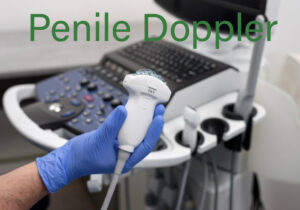

Nocturnal Penile Tumescence And Rigidity(NPT)
Nocturnal Penile Tumescence and Rigidity test is also known as Rigiscan. It is performed to establish the diagnosis of ED. Patient wear a plastic, ring-like device around penis to test whether he have erections during the night while he sleep. Test uses an electronic monitoring device that will record how firm the erections are, the number of erections, and how long they last. Each night during deep sleep, a man normally has three to five erections. If patient have erections during test, it shows that he is physically able to have an erection and cause of ED is psychological. If patient do not have an erection during test, his ED is due to a physiological reason.
DICC
For the diagnosis of Venous Leak ED, a confirmatory test is done known as Dynamic Infusion Cavernosometry and Cavernosography i.e. DICC. The procedure require administration of an erectogenic medicine.This test documents
Severity of venous leak
Sites of leakage
Venous Leak is confirmed if cavernosometry results are (i) an intracavernosal infusion rate of greater than 10 cc/minute of saline to maintain the erection. (ii) drop of intracavernosal pressure of greater than 50 mmHg within 30 seconds of terminating the saline infusion. And cavernosogram shows visualization of penile veins or venous leakage from the crura.

 Dr. SP Singh Clinic[/caption]
Dr. SP Singh Clinic[/caption]